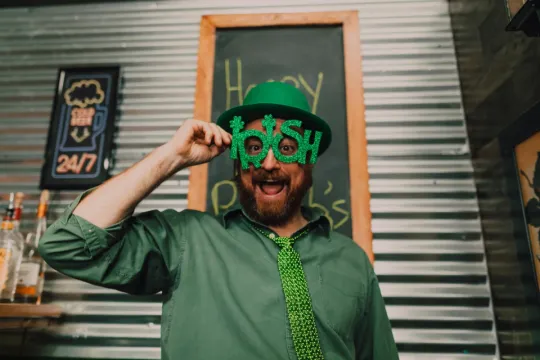Irish dance: rhythm, tradition, and Celtic passion

Irish dance, also known as Irish dancing , is one of Ireland's most iconic cultural expressions. With its lively rhythm, precise movements, and deep connection to Celtic music, Irish dance has captivated the world. From small rural towns to major international stages like Riverdance , this tradition has evolved without losing its essence.
In this blog, we explore the history of Irish dance, its different styles, its importance in Irish culture today, and how you can learn it wherever you are.
- Origins of Irish dance
The roots of Irish dance date back to Celtic times, before the arrival of Christianity. At this time, the Celts were already performing round dances during religious festivals and seasonal rituals such as Samhain and Beltane . These ancient dance forms celebrated the connection with nature and the gods.
With the arrival of Christian missionaries and, later, Norman and English settlers, Irish dance developed and adapted under the influence of European court dances. However, it has retained its distinctive character: rigid body movements, very fast footwork, and a constant connection to traditional Irish music.
- Main styles of Irish dance
Irish dance is not a single discipline, but encompasses several styles, each with its own unique characteristics.
Traditional group dance (Céilí and Set Dance)
- Ceili Dance : This dance is performed in groups and includes structured steps. It is very popular at school and community festivals.
- Group dance : Closer to European couple dances such as the quadrille. The dance is performed in formations of four couples.
Both styles are characterized by a strong sense of community and are practiced in social gatherings with live music.
Solo dance
This style became world-famous through shows like Riverdance . It is danced individually, with an upright posture and arms extended. There are two types of solo dancing:
- Light shoes: Shoes similar to dance shoes. The steps are quick, light, and often include very high jumps.
- Stiff shoes: Shoes similar to tap shoes that produce rhythmic sounds when they hit the floor. This is the most characteristic style of modern Irish dance.
- Riverdance and its worldwide popularity
Irish dance celebrated its greatest international success in 1994, when Riverdance was performed during the Eurovision Song Contest halftime show in Dublin. The show, choreographed by Jean Butler and Michael Flatley, combined traditional dance and modern theater.
The success was immediate, and Riverdance became an international spectacle, touring the world from New York to Tokyo. This made Irish dance a symbol of Celtic culture and attracted thousands of new students and spectators.
- Traditional Irish dance costume
Irish dance costumes are as distinctive as the music. Although styles vary by school or dance style, there are some common elements:
- Embroidered dresses: The dancers' costumes are often inspired by Celtic motifs and may feature elaborate embroidery. The colors are vibrant, and each dress can be unique.
- Curly Wigs: Traditionally, dancers wear wigs with voluminous curls, an aesthetic that has been maintained over time.
- Special footwear: Ghillies (soft shoes) and hard shoes (hard shoes) are essential for practicing any style.
- Accessories: In some competitions, the use of shiny crowns or tiaras is permitted.
Male dancers typically wear formal shirts, dark trousers, and sometimes decorated vests.
- The music that accompanies the dance.
Irish dance is unthinkable without traditional music. Instruments such as the fiddle , the penny whistle , the accordion, the bodhrán (Irish drum), and the uilleann pipe are its mainstays.
The most danced pieces include:
- Reels : Fast and fluid rhythm.
- Jigs : There are different types (double jig, slip jig, etc.), each with its own compass.
- Hornpipes : More pronounced and with emphasis on the first and third beats of the measure.
Each type of music requires specific steps and a different energy.
- Skills and Certifications
Irish dance is not only an art but also a competitive sport. There are local, national, and international competitions called Feiseanna (plural of Feis ).
The most prestigious tournament is the Oireachtas Rince na Cruinne (World Irish Dance Championships), which brings together the world's best dancers.
There are also tier and certification systems. The Dublin-based Irish Dance Commission (CLRG) is the world's leading regulatory body for Irish dance. To teach, teachers must obtain official qualifications such as the TCRG (Teacher of Irish Dance).
- Learning Irish Dance: Where to Start?
You don't have to live in Ireland to learn this art. Today, there are Irish dance schools on almost every continent, from Latin America to Asia. Here are some tips to get you started:
- Look for a school registered with CLRG or a similar organization.
- Start with soft shoes before moving to hard shoes.
- Be consistent Technology requires discipline and practice.
- Attend Irish cultural events in your city.
- Have fun! Although it can be a competition, Irish dance is also a way to celebrate life.
You can also learn from home with virtual courses, video tutorials, and dedicated educational platforms.
- The cultural influence of Irish dance
Beyond its aesthetic beauty, Irish dance embodies resilience, identity, and community. Throughout centuries of colonization and cultural oppression, the Irish have preserved their dances as a form of expression and pride.
Today, Irish dance connects generations, transcends borders, and unites people of different cultures. Every step echoes history, and every click of a shoe tells a story of struggle, joy, and freedom.
Diploma
Irish dance is a living art that combines history, discipline, emotion, and community. Whether on the international stage, in a local competition, or at a family gathering, this dance remains a source of identity and celebration.
Discover Irish dance: history, styles, music, costumes, and how to learn this traditional Celtic dance. Discover its cultural impact and how to dance it wherever you are in the world. Feel the rhythm and passion of Ireland with every step!